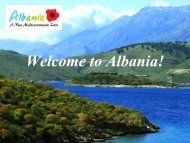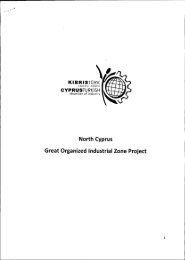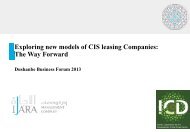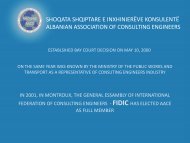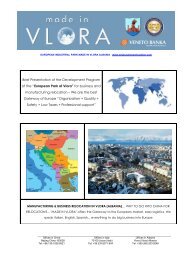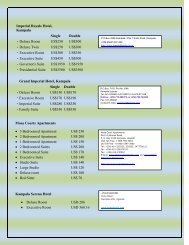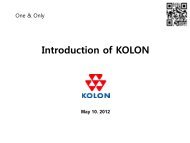PET Recycling to Bottle - IDB Group Business Forum
PET Recycling to Bottle - IDB Group Business Forum
PET Recycling to Bottle - IDB Group Business Forum
- No tags were found...
Create successful ePaper yourself
Turn your PDF publications into a flip-book with our unique Google optimized e-Paper software.
as a textile material. Its strength, temperature <strong>to</strong>lerance and wear-resistance made it an ideal replacement for,or addition <strong>to</strong> natural fibers such as silk, cot<strong>to</strong>n and wool.It has good antiosmosis, low water absorbability and good <strong>to</strong>ughness. <strong>PET</strong> film's tensile strength is similar withaluminum film's, and is three times that of PC and PA film. <strong>PET</strong> film is transparent. It's tensile strength canreach 1/3~1/2 of steel's if dealed by oriented draw. It's the <strong>to</strong>ughest thermoplastic film. It will be burnt withyellow flame and will burst when burning. And it will continue burning when away from fire.Unlike simple polymers such as polyethylene, <strong>PET</strong> is not made by a single stage process, but by the reactionbetween two chemicals, purified terephthalic acid (PTA) and ethylene glycol (EG). The availability of the first ofthese has dictated the supply of <strong>PET</strong> resin in the past, but new capacity coming on stream this year will ensuremore than adequate supplies <strong>to</strong> meet the growing uses of <strong>PET</strong> over the coming years. Related polyesters arepolybutylene terephthalate (PBT) used mainly for engineering applications, and polyethylene naphthalate(PEN). The latter offers significant performance improvements over <strong>PET</strong>, particularly in terms of barrierproperties and heat <strong>to</strong>lerance. Since PEN can be blended with <strong>PET</strong> a range of new 'alloys' is becoming availablefor special packaging applications.The process of <strong>PET</strong> recycling is made in three phases. The first phase has two steps: the processes of collecting<strong>PET</strong> bottles and process them <strong>to</strong> <strong>PET</strong> bottle bails through processes of selection for the material and the colorand the second step transforming bails <strong>to</strong> <strong>PET</strong> flakes. Three types of selection are made in <strong>PET</strong> bail process;bottles without color (transparent bottles), bottles with blue and green color, and dark bottles. Then the bottlesare pressed and bailed in the standard size of bails for transportation.The second step is where the <strong>PET</strong> bail bottles are transformed <strong>to</strong> <strong>PET</strong> flakes. This process includes the sorting,pre washing, washing, cutting, separation of labels and PVC from the <strong>PET</strong>, drying and packaging <strong>PET</strong> flakes inthe bags with around 1 <strong>to</strong>n per bag. This phase is important because the dirty and the PVC need <strong>to</strong> be clearedaway in order that the <strong>PET</strong> flakes are in the food quality grade.The process is a combination of conventional mechanical methods and chemical recycling. The prime materialsupplied <strong>to</strong> the plant consists of <strong>PET</strong> beverage bottles, sorted by colour. The bottles are supplied in the form ofcompressed bales, each containing between 3,000 and 5,000 bottles. Each bale is given an electronic identity inorder <strong>to</strong> facilitate traceability in the material stream as well as au<strong>to</strong>matic material s<strong>to</strong>rage and control. Thebales are loaded on<strong>to</strong> a conveyor belt and unstrapped <strong>to</strong> free the bottles, which are fed <strong>to</strong> one of twoshredders.The material is shredded, in a dry state, down <strong>to</strong> a unified granule size. The resultant material is a mixture of<strong>PET</strong>, labels and closures, which must be separated. The plastic and paper labels are removed from the streamby an air blowing process. Any labels adhering <strong>to</strong> the <strong>PET</strong> with glue are subsequently removed by intensivewashing. In the next stage polyolefins (closures) and <strong>PET</strong> are separated using the difference in their densities.The cleaned and sorted <strong>PET</strong> flake is now coated with caustic soda as it passes through a special washer anddryer. The materials have <strong>to</strong> be dried as they enter the package unit.The second step is <strong>to</strong> transform the <strong>PET</strong> flakes in <strong>to</strong> <strong>PET</strong> granules that has as nearest technical and chemicalproperties as the virgin <strong>PET</strong>. This is archived by processing the <strong>PET</strong> flakes in the grinding reac<strong>to</strong>r that changesthe intrinsic viscosity of recycled <strong>PET</strong> flakes by cutting and fractioning it. During this process is produced heatthat helps the process of making material more viscous or in the other terms regenerating the length ofpolymer.In the bottle industry, the length of the <strong>PET</strong> chains is usually described by the resin IV (Intrinsic Viscosity).<strong>Bottle</strong> grades have IV values of about 0.65 <strong>to</strong> 0.85 dL/g, or about 100-155 repeating units per chain. Mostbottle grades of <strong>PET</strong> are copolymers, which means that a few percent of a modifier has been incorporated in<strong>to</strong>the polymer chain. Copolymers are easier <strong>to</strong> injection mold because the crystallinity behavior is improved.A remarkable transformation takes place when injection molded <strong>PET</strong> is stretched at the right temperatures and<strong>to</strong> the right extent. The long chains undergo strain-hardening and strain-induced crystallization, which gives theproperly-made <strong>PET</strong> bottle exceptional clarity, resistance <strong>to</strong> internal pressure, uniform wall thickness, <strong>to</strong>ughness,and a host of other features. To achieve these useful properties, however, care must be taken in choosing theright grade of resin, as well as the right perform and bottle designs, and good molding practices. The best way<strong>to</strong> recover the properties of the recycled <strong>PET</strong> is achieved using three reac<strong>to</strong>rs.




